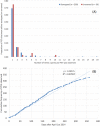Identification of Salmonella for public health surveillance using whole genome sequencing
- PMID: 27069781
- PMCID: PMC4824889
- DOI: 10.7717/peerj.1752
Identification of Salmonella for public health surveillance using whole genome sequencing
Abstract
In April 2015, Public Health England implemented whole genome sequencing (WGS) as a routine typing tool for public health surveillance of Salmonella, adopting a multilocus sequence typing (MLST) approach as a replacement for traditional serotyping. The WGS derived sequence type (ST) was compared to the phenotypic serotype for 6,887 isolates of S. enterica subspecies I, and of these, 6,616 (96%) were concordant. Of the 4% (n = 271) of isolates of subspecies I exhibiting a mismatch, 119 were due to a process error in the laboratory, 26 were likely caused by the serotype designation in the MLST database being incorrect and 126 occurred when two different serovars belonged to the same ST. The population structure of S. enterica subspecies II-IV differs markedly from that of subspecies I and, based on current data, defining the serovar from the clonal complex may be less appropriate for the classification of this group. Novel sequence types that were not present in the MLST database were identified in 8.6% of the total number of samples tested (including S. enterica subspecies I-IV and S. bongori) and these 654 isolates belonged to 326 novel STs. For S. enterica subspecies I, WGS MLST derived serotyping is a high throughput, accurate, robust, reliable typing method, well suited to routine public health surveillance. The combined output of ST and serovar supports the maintenance of traditional serovar nomenclature while providing additional insight on the true phylogenetic relationship between isolates.
Keywords: Bioinformatics; Multi-locus sequence typing; Public health; Salmonella; Whole genome sequencing.
Conflict of interest statement
The authors declare there are no competing interests
Figures




References
-
- Achtman M, Wain J, Weill FX, Nair S, Zhou Z, Sangal V, Krauland MG, Hale JL, Harbottle H, Uesbeck A, Dougan G, Harrison LH, Brisse S, S. Enterica MLST Study Group Multilocus sequence typing as a replacement for serotyping in Salmonella enterica. PLoS Pathogens. 2012;8(6):e1752. doi: 10.1371/journal.ppat.1002776. - DOI - PMC - PubMed
-
- Ashton PM, Peters T, Ameh L, McAleer R, Petrie S, Nair S, Muscat I, De Pinna E, Dallman T. Whole genome sequencing for the retrospective investigation of an outbreak of Salmonella Typhimurium DT 8. PLoS Currents. 2015 doi: 10.1371/currents.outbreaks.2c05a47d292f376afc5a6fcdd8a7a3b6. Epub ahead of print Feb 10 2015. - DOI - PMC - PubMed
-
- Dallman TJ, Byrne L, Ashton PM, Cowley LA, Perry NT, Adak G, Petrovska L, Ellis RJ, Elson R, Underwood A, Green J, Hanage WP, Jenkins C, Grant K, Wain J. Whole-genome sequencing for national surveillance of Shiga Toxin-producing Escherichia coli O157. Clinical Infectious Diseases. 2015;61(3):305–312. doi: 10.1093/cid/civ318. - DOI - PMC - PubMed
LinkOut - more resources
Full Text Sources
Other Literature Sources
Miscellaneous

